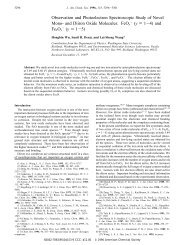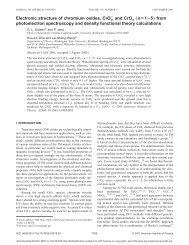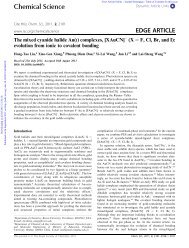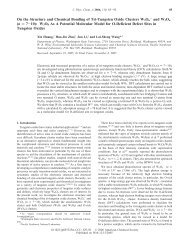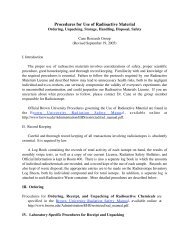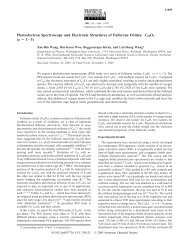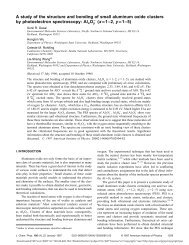Unique CO Chemisorption Properties of Gold Hexamer - Chemistry ...
Unique CO Chemisorption Properties of Gold Hexamer - Chemistry ...
Unique CO Chemisorption Properties of Gold Hexamer - Chemistry ...
You also want an ePaper? Increase the reach of your titles
YUMPU automatically turns print PDFs into web optimized ePapers that Google loves.
<strong>Unique</strong> <strong>CO</strong> <strong>Chemisorption</strong> <strong>Properties</strong> <strong>of</strong> <strong>Gold</strong> <strong>Hexamer</strong><br />
(30) Lopez, N.; Norskov, J. K. J. Am. Chem. Soc. 2002, 124, 11262.<br />
(31) While oxide support is observed to play important roles in nanogold catalysis<br />
(ref 2), there is accumulating evidence that the size <strong>of</strong> nanogold overwhelmingly<br />
determines the catalytic activity (refs 2 and 13). Nanogold is<br />
an active catalyst even without oxide support (ref 4), which justifies<br />
chemisorbed gold cluster complexes as molecular models for mechanistic<br />
understanding <strong>of</strong> nanogold catalysts.<br />
(32) Zhai, H. J.; Wang, L. S. J. Chem. Phys. 2005, 122, 051101.<br />
(33) Furche, F.; Ahlrichs, R.; Wies, P.; Jacob, C.; Gilb, S.; Bierweiler, T.;<br />
Kappes, M. M. J. Chem. Phys. 2002, 117, 6982.<br />
been carried out to model this catalytic reaction in a wellcontrolled<br />
manner, providing fundamental mechanistic information<br />
at the molecular level. Chemisorbed gold cluster complexes<br />
serve as ideal model systems for nanogold catalysts, even though<br />
the role <strong>of</strong> substrates cannot be addressed. 31 Numerous mass<br />
spectrometric, 19 photoelectron spectroscopic, 15 and density<br />
functional theory (DFT) 15,25,26,29 studies have established that<br />
O 2 adsorbs on gold clusters molecularly. Evidence for molecular<br />
chemisorption <strong>of</strong> O 2 on TiO 2 -supported gold nanoparticles has<br />
also been observed recently. 5 Coadsorption <strong>of</strong> <strong>CO</strong> and O 2 on<br />
small gold clusters has been investigated by mass-spectrometrybased<br />
experiments, and it was revealed that <strong>CO</strong> and O 2 adsorb<br />
cooperatively, rather than competitively. 17,18<br />
However, little experimental information is available on how<br />
<strong>CO</strong> molecules interact with gold clusters and gold nanoparticles.<br />
19-23 Chemical reactions <strong>of</strong> gold clusters with <strong>CO</strong> have<br />
been studied, 19-22 and pronounced size dependence and saturation<br />
were observed. Infrared spectra <strong>of</strong> Au-<strong>CO</strong> complexes<br />
formed in a rare gas matrix have been reported, 23 and complexes<br />
such as Au(<strong>CO</strong>) n (n ) 1-5) and Au n (<strong>CO</strong>) 2 (n ) 1, 2) were<br />
assigned. However, definitive electronic and structural information<br />
on the Au m (<strong>CO</strong>) n complexes is still elusive. Such information<br />
would be valuable in the mechanistic understanding for<br />
the catalytic <strong>CO</strong> oxidation by gold nanoparticles.<br />
In a recent communication, 32 we reported the generation <strong>of</strong><br />
several series <strong>of</strong> gold carbonyl cluster anions Au m (<strong>CO</strong>) - n (m )<br />
2-5, n ) 1-7) in the gas phase and characterized their<br />
electronic structure using photoelectron spectroscopy (PES). We<br />
observed that the first few <strong>CO</strong> groups induce significant red<br />
shifts to the photoelectron spectra, suggesting that <strong>CO</strong> acts as<br />
electron donors to the gold clusters. For a given gold cluster,<br />
<strong>CO</strong> adsorption reaches a critical number, beyond which further<br />
<strong>CO</strong> adsorption changes the spectra very little. The critical <strong>CO</strong><br />
numbers correspond exactly to the available low coordination<br />
apex sites on the respective bare gold clusters. It was suggested<br />
that <strong>CO</strong> first chemisorbs to the apex sites and additional <strong>CO</strong><br />
then only physisorbs to the chemisorption-saturated Au m (<strong>CO</strong>)<br />
- n<br />
complexes. The observation that <strong>CO</strong> chemisorption induces<br />
significant decreases to the electron binding energies <strong>of</strong> the<br />
Au m (<strong>CO</strong>) - n complexes is important, suggesting that <strong>CO</strong> chemisorption<br />
would promote O 2 adsorption because the latter<br />
involves electron transfers from the cluster. Thus the previous<br />
experimental results provided electronic and spectroscopic basis<br />
for the cooperative chemisorption <strong>of</strong> <strong>CO</strong> and O 2 on gold clusters<br />
and may hold the key for the mechanistic understanding <strong>of</strong><br />
nanogold catalysts for <strong>CO</strong> oxidation. However, a detailed<br />
molecular understanding about how <strong>CO</strong> interacts with gold is<br />
still lacking.<br />
In the current paper, we report a combined PES and DFT<br />
investigation <strong>of</strong> the <strong>CO</strong> chemisorption behavior on the gold<br />
hexamer from one to three <strong>CO</strong> groups, Au 6 (<strong>CO</strong>) - n (n ) 0-3).<br />
Bare gold hexamer has unique electronic and structural<br />
properties. 33-36 Structurally, Au 6 and Au - 6 were well-characterized<br />
to possess a close-packed planar triangular structure with<br />
D 3h symmetry. 36 This highly symmetric structure, stabilized by<br />
strong relativistic effects, 37 aromaticity, and aurophilic attraction,<br />
38 may be viewed as a small piece <strong>of</strong> Au(111) surface or<br />
an ideal model catalytic surface composed <strong>of</strong> apex and edge<br />
sites only. Electronically, Au 6 is known to possess the largest<br />
HOMO-LUMO gap among gold clusters 34,35 and has been<br />
proposed to be a six-electron magic cluster within a twodimensional<br />
electronic shell model. 39 Upon <strong>CO</strong> chemisorption,<br />
we observed surprisingly that the first three <strong>CO</strong> chemisorptions<br />
do not significantly change the electron binding energies <strong>of</strong> the<br />
first PES band in Au 6 (<strong>CO</strong>) - n (n ) 1-3), in direct contrast to<br />
our previous study on the smaller Au m (<strong>CO</strong>) - n (m ) 2-5)<br />
complexes. Only the binding energies <strong>of</strong> the second PES band<br />
in Au 6 (<strong>CO</strong>) - n were observed to be red-shifted, resulting in a<br />
closing <strong>of</strong> the HOMO-LUMO gaps upon <strong>CO</strong> chemisorption.<br />
We also performed extensive quasi-relativistic DFT calculations<br />
to examine chemisorption structures in Au 6 (<strong>CO</strong>) - n and Au 6 -<br />
(<strong>CO</strong>) n (n ) 1-3). We found that the first three <strong>CO</strong> successively<br />
chemisorb to the apex sites <strong>of</strong> the triangular Au 6 without<br />
significantly perturbing the parent Au 6 structure. The unique<br />
<strong>CO</strong> chemisorption behavior and its influence on the electronic<br />
structure <strong>of</strong> Au 6 are understood using molecular orbital analysis,<br />
providing detailed information about the molecular and electronic<br />
interactions between <strong>CO</strong> and Au 6.<br />
2. Experimental and Computational Methods<br />
ARTICLES<br />
2.1. Photoelectron Spectroscopy. The experiments were carried out<br />
using a magnetic-bottle-type PES apparatus equipped with a laser<br />
vaporization supersonic cluster source, details <strong>of</strong> which were described<br />
elsewhere. 40 Briefly, Au m(<strong>CO</strong>) n- cluster anions were produced by laser<br />
vaporization <strong>of</strong> a pure gold target in the presence <strong>of</strong> a helium carrier<br />
gas seeded with 2% <strong>CO</strong>. Various Au m(<strong>CO</strong>) n- clusters were generated<br />
and mass-analyzed using a time-<strong>of</strong>-flight mass spectrometer. The<br />
Au 6(<strong>CO</strong>) n- (n ) 1-3) species were each mass-selected and decelerated<br />
before being photodetached. Three detachment photon energies were<br />
used in the current study: 532 nm (2.331 eV), 266 nm (4.661 eV),<br />
and 193 nm (6.424 eV). Photoelectrons were collected at nearly 100%<br />
efficiency by the magnetic bottle and analyzed in a 3.5 m long electron<br />
flight tube. The PES spectra were calibrated using the known spectra<br />
<strong>of</strong> Au - and Rh - , and the energy resolution <strong>of</strong> the apparatus was ∆E k/<br />
E k ∼2.5%, that is, ∼25 meV for 1 eV electrons.<br />
(34) Hakkinen, H.; Yoon, B.; Landman, U.; Li, X.; Zhai, H. J.; Wang, L. S. J.<br />
Phys. Chem. A 2003, 107, 6168.<br />
(35) Taylor, K. J.; Jin, C.; Conceicao, J.; Wang, L. S.; Cheshnovsky, O.; Johnson,<br />
B. R.; Nordlander, P. J.; Smalley, R. E. J. Chem. Phys. 1990, 93, 7515.<br />
Taylor, K. J.; Pettiette-Hall, C. L.; Cheshnovsky, O.; Smalley, R. E. J.<br />
Chem. Phys. 1992, 96, 3319. Gantefor, G.; Cox, D. M.; Kaldor, A. J. Chem.<br />
Phys. 1992, 96, 4102. Liao, D. W.; Balasubramanian, K. J. Chem. Phys.<br />
1992, 97, 2548.<br />
(36) Bravo-Perez, G.; Novaro, O. Chem. Phys. Lett. 1999, 313, 655. Hakkinen,<br />
H.; Landman, U. Phys. ReV.B2000, 62, R2287. Wang, J.; Wang, G.; Zhao,<br />
J. Phys. ReV.B2002, 66, 035418. Bonacic-Koutecky, V.; Burda, J.; Mitric,<br />
R.; Ge, M.; Zampella, G.; Fantucci, P. J. Chem. Phys. 2002, 117, 3120.<br />
Lee, H. M.; Ge, M.; Sahu, B. R.; Tarakeshwar, P.; Kim, K. S. J. Phys.<br />
Chem. B 2003, 107, 9994. Fernandez, E. M.; Soler, J. M.; Garzon, I. L.;<br />
Balbas, L. C. Phys. ReV.B2004, 70, 165403. Xiao, L.; Wang, L. C. Chem.<br />
Phys. Lett. 2004, 392, 452. Remacle, F.; Kryachko, E. S. J. Chem. Phys.<br />
2005, 122, 044304. Olson, R. M.; Varganov, S.; Gordon, M. S.; Meitu,<br />
H.; Chretien, S.; Piecuch, P.; Kowalski, K.; Kucharski, S. A.; Musial, M.<br />
J. Am. Chem. Soc. 2005, 127, 1049.<br />
(37) Pyykko, P. Chem. ReV. 1988, 88, 563.<br />
(38) Schmidbaur, H. <strong>Gold</strong> Bull. (London) 2000, 33, 3.<br />
(39) Tanaka, H.; Neukermans, S.; Janssens, E.; Silverans, R. E.; Lievens, P. J.<br />
Am. Chem. Soc. 2003, 125, 2862. Janssens, E.; Tanaka, H.; Neukermans,<br />
S.; Silverans, R. E.; Lievens, P. New. J. Phys. 2003, 5, 46.<br />
(40) Wang, L. S.; Cheng, H. S.; Fan, J. J. Chem. Phys. 1995, 102, 9480. Wang,<br />
L. S.; Wu, H. B. In AdVances in Metal and Semiconductor Clusters. IV.<br />
Cluster Materials; Duncan, M. A., Ed.; JAI Press: Greenwich, CT, 1998;<br />
pp 299-343.<br />
J. AM. CHEM. SOC. 9 VOL. 127, NO. 34, 2005 12099



